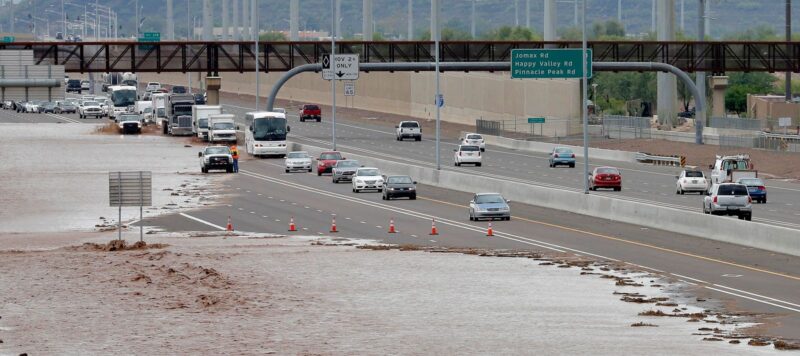This flood a decade ago closed multiple lanes on an interstate in Phoenix
Copyright 2014 AP. All rights reserved.
The Phoenix area saw one of its highest rainfall storms in a decade, resulting in flooding on many streets. Several of these floods were encountered by Waymo robotaxis, including one that got stuck in the flood and was abandoned by its passengers, as seen below. This led Waymo to suspend service in the area for a period. What could they do to avoid this, and how can they do better in the future?
Waymo puts some of the blame on the flood being extraordinary; several places flooded that had not been seen to flood before. Even so, Waymo has described a number of steps they take to avoid this sort of situation, including watching weather reports, having maps of areas expected to flood, and uploading reports of any flooding seen into their maps so that other vehicles can route around them.
On top of that, the vehicles are able to detect flood water on the roads, or when a vehicle drives into water. Not apparently perfectly though. Because Waymos have detailed 3-D maps of the roads, they actually should be able to look at the surface shape of a flood and know exactly how deep it is, something no human could do. (Frequently flooded roads sometimes have polls with depth markers on them to assist humans.) As electric vehicles, Waymos could be designed to drive safely through quite deep floods–they need have no air intake–though most EVs are not designed for this and can fail if water gets into their electrical systems.
Waymos will execute turn-arounds when they encounter floods and other obstacles blocking roads. Reports for the event above suggest the flood came upon that road very suddenly. (Waymo recently got ticketed for making a U-turn at a sobriety checkpoint, something that’s illegal for humans, but need not be illegal for a robot that can’t drink.)
Another option, which Waymos don’t yet do but which Zoox vehicles are designed to do is the instant turnaround. Zoox designed their vehicles to be bidirectional, with no specific front or back. That means if they need to turn around instantly, they could, by just reversing direction and switching to the other side of the street (unless it’s a one-way street, and even then if it’s a road blockage.) Today, vehicles like a Waymo use a more standard 3-point or mulitpoint turn to reverse in such situations. They could also be designed to reverse like the Zoox – unlike humans, robots have no trouble driving backwards at fairly high speeds, and electric cars can often go full speed in reverse. All they would need would be suitable lights on front and back, though it would, until people got used to it, confuse other drivers a bit, so it would be best if it were done only for short distances until the vehicle finds an easy spot for a quick turnaround. Nobody would begrudge it escaping a flood.
The Zoox design has no front or back, so it can instantly turn around. They have begun limited route service in Las Vegas
Gado via Getty Images
Flooding is a rare enough situation that it should be handled by the human remote assistance team that Waymo and all other companies have. When a vehicle sees a flooded area, let a human decide whether to turn around, or monitor the vehicle if it tries to cross. EVs are heavy enough that they would need to get pretty deep before they floated, even if sealed. This scales fine because the flood is then put on the map, and all other cars will route around it if they have a choice.
Another important realization is that Waymo, after these floods, has begun work to fix any problems and not repeat any errors. While we are always very interested in any mistakes robocars make, the good news is that robots will never repeat their mistakes, as the team learns from them and stops that particular mistake from happening again. This is very much unlike humans–while one human will learn from a mistake, with robots, every robot gets the software update. Even robots from other companies, who pay attention to news of the mistakes of their competitors. Any situation that went wrong will likely go into the simulation library for all the teams, so they can test if their vehicles will also have a problem, and eliminate it.









